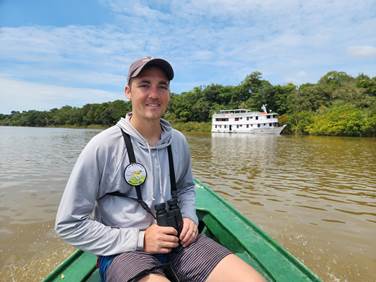- No products in the cart.

Clayton Leopold
 Clayton Leopold grew up in a small rural community just outside of Victoria, Texas. In his youth, wildlife and birds were a major focus, spending many hours on the back porch watching the bird feeders. Clayton graduated college in 2012 from Texas A&M Galveston with two degrees, Marine Fisheries and Marine Biology. In 2013 he was formally introduced to birding by a close friend. Since then, Clayton has volunteered for several birding festivals and events, leading tours around the Galveston area. Clayton enjoys birding most areas of the state, but has a soft spot for West Texas, making multiple trips a year. Clayton and his wife Linsey have two young kids, Laiken Maxine and Cassin Clayton, both of which have a love for the outdoors. “The joy of birding is about appreciating the challenge of identification, peace of being in nature, and comradery of fellow birders.”
Clayton Leopold grew up in a small rural community just outside of Victoria, Texas. In his youth, wildlife and birds were a major focus, spending many hours on the back porch watching the bird feeders. Clayton graduated college in 2012 from Texas A&M Galveston with two degrees, Marine Fisheries and Marine Biology. In 2013 he was formally introduced to birding by a close friend. Since then, Clayton has volunteered for several birding festivals and events, leading tours around the Galveston area. Clayton enjoys birding most areas of the state, but has a soft spot for West Texas, making multiple trips a year. Clayton and his wife Linsey have two young kids, Laiken Maxine and Cassin Clayton, both of which have a love for the outdoors. “The joy of birding is about appreciating the challenge of identification, peace of being in nature, and comradery of fellow birders.”
Upcoming Events
April 2025
April 24 @ 6:30 am - 11:30 am
Galveston is a Gulf coastal island renowned for its many habitats. On the Gulf beaches, you’ll scan out on the swells and incoming surf for rafts of waterfowl and seabirds. Walking along the beach the edge of the surf is active with the antics of the island’s year-round and migrating peeps, Reddish Egret, Great Blue Heron, and shorebirds foraging on “what the tide brung-in.” Away from the water among the dunes of San Luis Pass, East Beach and GISP, Savannah Sparrow and Horned Lark flit about. Beyond the dunes are briny ponds holding roosting seabirds, Nelson’s and Seaside Sparrows, rails, coots, and water birds. In the bay and tidal marshes migrating and nesting herons, egrets and cormorants in their breeding best, forage. The avian fauna is always in flux with the advance and retreat of the tide moving the food chain in and out. Among the tidally influenced habits and the open coastal prairies and oak mottes migrating songbirds need to refuel and find fresh water.
Find out more »
April 24 @ 3:00 pm - 7:00 pm
The accident of geology makes the Upper Texas Coast a beacon to weary neotropical migrants finishing a 10+ hour, nonstop flight across the Gulf of Mexico. From under an ancient sea, a salt dome emerged. After a few thousand years the dome reached just 38-feet above a pancake-flat coastal plain where it became covered with 20-30-foot oak trees, creating a vast canopy. This created High Island, which is now a beacon to weary Trans-Gulf migrants. This area provides wooded habitat…
Find out more »
April 25 @ 8:00 am - 11:00 am
Join Clayton Leopold on a guided tour of the birds of Moody Gardens. This unique combination field trip will include a guided tour through the canopy level of the Tropical Rainforest exhibit as well as a viewing of the Penguins in the Aquarium Pyramid. You will learn everything you wanted to know about how our Life Science and Exhibit Operations team manages a diverse collection of tropical species within the Rainforest biome as well as the 7 species of penguins…
Find out more »
$75
Texas Targets
April 26 @ 7:00 am - 3:00 pm
Join Clayton Leopold and Jeff Sexton for this open-ended trip geared for those who come to the Texas Gulf Coast to focus on bird species with range limits in this area. These include local specialties such as Roseate Spoonbill, Wilson’s Plovers, Horned Lark, Seaside Sparrow, and White-tailed Kite. We will also attempt to find any rare species currently being reported. We will visit several top birding sites on Galveston Island and Bolivar Peninsula, with exact locations to be determined by…
Find out more »